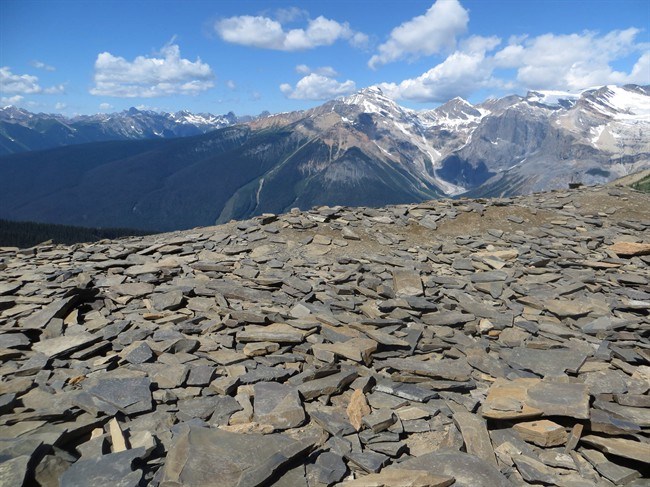FIELD, B.C. - It's hard to believe that this spot — a rocky ledge well above the tree line — was under water half a billion years ago.
Equally hard to believe is that the slab of shale in my hands has etched on it — in strikingly sharp detail — the remains of one of Earth's earliest creatures.
I beckon to our Parks Canada guide. She steps over the loose rock and kneels beside me to have a look at my find.
She confirms it's a trilobite, one of the more common Cambrian-era insect-like critters, whose squishy bodies enabled them to be incredibly well preserved as fossils.
The last time I felt so excited, so filled with awe, was when I was a child.
The Burgess Shale in Yoho National Park was named a UNESCO World Heritage Site in 1981. It's also part of the larger Rocky Mountain Parks UNESCO World Heritage site.
It's "the most prolific and most significant scientific site, paleontological site, in the world," said Randle Robertson, executive director of the Burgess Shale Geoscience Foundation.
"If you were to stand in Yoho Pass half a billion years ago, you could have walked in knee-deep water all the way to Winnipeg. If you'd stepped the other way, you would have stepped into one of the deepest parts of the ocean at that time," he said.
"And then the mountain-building process started and that's when everything got all turned upside-down."
Hiking to the fossil beds is forbidden without a guide from either Parks Canada or the Geoscience Foundation. For both, groups are limited to 12. Removing fossils from the site is against the law.
"The fossils need to stay where they were formed, where they occurred, where the story is," said Kathryn Cameron from the Lake Louise visitor's centre.
"Yes, they're curiosities. Yes, they're interesting. Yes, we'd love to have one on our mantel at home to talk about it. But we might be losing a really critical piece of the puzzle of life."
Hikes go four times weekly to Walcott Quarry between July and mid-September and twice weekly to the Mount Stephen fossil bed between late June and mid-September.
The Parks Canada Walcott Quarry hike costs $70 per adult, and the Mount Stephen one costs $55. The Geoscience Foundation offers hikes for $120 per adult to Walcott Quarry and $90 to Mount Stephen.
My friends and I chose to hike to Walcott Quarry — named for Charles Walcott, the American scientist who made the fossil bed discovery in 1909 — through Parks Canada last August.
The Geoscience Foundation hikes, led by professors and graduate students, tend to have more of a scientific focus than the Parks Canada ones. Most participants have academic backgrounds in biology, geology, paleontology and other scientific disciplines.
The Walcott Quarry hike is 22 kilometres round-trip, versus nine kilometres to Mount Stephen. But the route to Mount Stephen is significantly steeper than that to Walcott Quarry.
Our guide greeted us at 7:15 a.m. in the parking lot below Takakkaw Falls, about a half-hour's drive up the steep Yoho Valley road from the Trans-Canada Highway east of Field, B.C.
We shivered in the cold morning air as we did introductions and signed waivers. Our group included visitors from as near as Calgary, some 200 kilometres to the east, and as far away as Norway and the United Kingdom.
We warmed up quickly enough as we trudged up steep switchback trails through the forest, enjoying a stunning view of Takakkaw Falls through the trees.
Cameron recommends trekkers dress in layers and wear sturdy hiking boots that are well broken in.
"There are some really steep and slippery sections on the trail," she said. Some sections used to be travelled on horseback, the horseshoes polishing them smooth over the years.
It's wise for each hiker to bring at least two litres of water "and lots and lots of lunch and snacks," said Cameron.
"Keep your hydration and nutrition levels nice and high on the way up."
Hiking poles are also good to bring along, as they take a great deal of stress off of the knees on the descent.
In the Rocky Mountains — even at the height of summer — one has to be prepared for all types of weather.
"We say even if the weather forecast is going to be for full-on sunshine, for people to pack a rain coat and rain pants, extra socks," said Cameron.
The hike became less strenuous as we passed serene Yoho Lake and then ascended above the treeline, where there were stunning views of Emerald Lake below.
Along the way we saw elk, pikas and marmots. We were told that mountain goats up by the quarry are not an uncommon sight.
Then we came to the final stretch before we reached the quarry. It was tough negotiating the steep switchbacks, with no shelter from the blazing midday sun.
The town of Field is at 1,280 metres elevation, and at least 760 metres in elevation is gained throughout the hike. The journey can be tough for participants more used to life at sea level.
"This is elevation hiking. It's not just a walk in the park," said Robertson.
Before heading into the quarry, our guide provided helmets to protect us from falling rocks. Then we had about an hour to scour the shale for fossils before making our descent.
On the way back down, knees sore and feet blistering, my friends and I remarked to each other that the gorgeous hike would have been worthwhile, even without the fossils.
"It is just such a remarkable experience," said Cameron.
"The fossils, I think, are the icing on the cake."
———
If You Go...
Book a hike through Parks Canada: http://www.pc.gc.ca/eng/pn-np/bc/yoho/natcul/burgess.aspx
Book a hike through the Burgess Shale Geoscience Foundation: http://www.burgess-shale.bc.ca/
Accommodations and attractions in Field, B.C.: http://www.field.ca/
